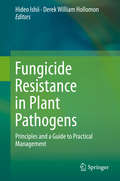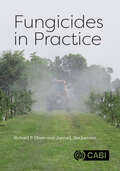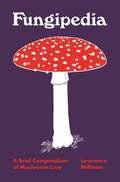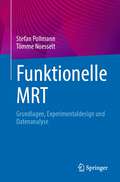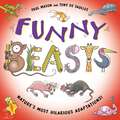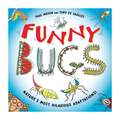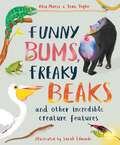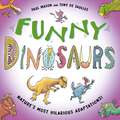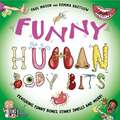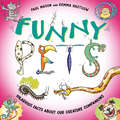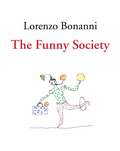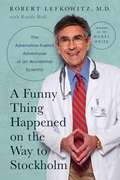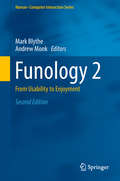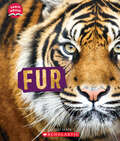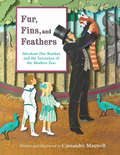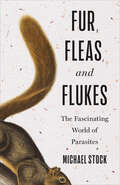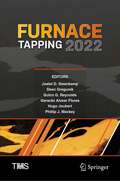- Table View
- List View
Fungicide Resistance in Plant Pathogens
by Hideo Ishii Derek William HollomonThis volume offers a comprehensive coverage of the general principles and recent advances in fungicide resistance. It describes the development, mechanisms, monitoring, and management of resistance and covers the most important group of fungicides that have caused resistance on various crops. An historical review of fungicide resistance over the past 40 years sets the scene for up-to-date basic information on mode of action, as well as the genetics, mechanisms, and evolution of resistance. Monitoring for resistance, including the latest developments in molecular diagnostics, moves readers into the practical aspects of resistance management, which is dealt with through a series of case studies outlining fungicide-use strategies on several key crops. The chapters reflect the experience of authors internationally recognised for their significant contributions to fungicide resistance research. The majority of crop diseases are caused by fungal pathogens, and disease control relies heavily on chemically synthesized fungicides. However, modern fungicides often encounter the problem of resistance development in target pathogens. Thus pathogen resistance to fungicides is an important factor that causes loss of yield and quality of crops. It often threatens biosecurity through the decrease of fungicide efficacy in the fields. To manage fungicide resistance successfully will require the promotion of integrated disease management, involving not just chemical fungicides, but also host plant resistance, agronomic factors, and reliable biological control agents where these are available. Well referenced throughout, the book offers a comprehensive account of resistance, which will be useful as a source of material for lecturers and for both industrial and academic scientists involved in fungicide resistance research. It is also a valuable sourcebook for students.
Fungicides in Practice
by Richard P. Oliver Professor Janna L BeckermanThis is an up-to-date guide on the science and practice of disease control based on fungicides in horticulture and broad acre agriculture. It describes how conventional, organic and biological fungicides are discovered, how they work and how resistance evolves. Chapters on formulation, mode of action, mobility and application inform decisions about which fungicides to use, when to use them, and how to rotate (or tank-mix) them, to manage both plant disease and fungicide resistance. A chapter on experimental design of fungicide trials aids practitioners in designing their own trials to evaluate how effective products are for their plant disease problem. Based on the successful 2014 book of Fungicides in Crop Protection this edition has four entirely new chapters, and extensive updates to the other nine chapters. The contents include: · Fungicide markets, discovery and performance. · Modes of action and spectrum. · Biological crop protection, and organic cultivation. · Fungicide formulation, mobility and application. · Experimental design of fungicide trials and their analysis. · Fungicide resistance. · Legislation and regulation. Written for crop protection professionals and scientists, growers, agronomists and consultants, the book is also suitable for students of agriculture and agronomy.
Fungipedia: A Brief Compendium of Mushroom Lore
by Fungipedia Lawrence MillmanAn illustrated mini-encyclopedia of fungal lore, from John Cage and Terrence McKenna to mushroom sex and fairy ringsFungipedia presents a delightful A–Z treasury of mushroom lore. With more than 180 entries—on topics as varied as Alice in Wonderland, chestnut blight, medicinal mushrooms, poisonings, Santa Claus, and waxy caps—this collection will transport both general readers and specialists into the remarkable universe of fungi.Combining ecological, ethnographic, historical, and contemporary knowledge, author and mycologist Lawrence Millman discusses how mushrooms are much more closely related to humans than to plants, how they engage in sex, how insects farm them, and how certain species happily dine on leftover radiation, cockroach antennae, and dung. He explores the lives of individuals like African American scientist George Washington Carver, who specialized in crop diseases caused by fungi; Beatrix Potter, creator of Peter Rabbit, who was prevented from becoming a professional mycologist because she was a woman; and Gordon Wasson, a J. P. Morgan vice-president who almost single-handedly introduced the world to magic mushrooms. Millman considers why fungi are among the most significant organisms on our planet and how they are currently being affected by destructive human behavior, including climate change.With charming drawings by artist and illustrator Amy Jean Porter, Fungipedia offers a treasure trove of scientific and cultural information. The world of mushrooms lies right at your door—be amazed!
Funktionelle MRT: Grundlagen, Experimentaldesign und Datenanalyse
by Stefan Pollmann Tömme NoesseltDie Funktionelle Magnetresonanztomographie (fMRT) hat sich als bahnbrechendes Instrument in den humanen Neurowissenschaften etabliert und wird in verschiedenen Disziplinen wie Medizin, Psychologie und Biologie sowohl für grundlagenwissenschaftliche als auch klinische Untersuchungen eingesetzt. "Einführung in die Funktionelle Magnetresonanztomographie" bietet eine verständliche Einführung in die Grundlagen der fMRT sowie eine ausführliche Erklärung der Designprinzipien von fMRT-Experimenten und der komplexen Schritte der Datenanalyse, einschließlich moderner multivariater Analyseverfahren.Dieses Buch ist sowohl für Einführungskurse auf Masterniveau als auch zum Selbststudium bei der Durchführung von fMRT-Projekten geeignet. Es führt den Leser durch alle notwendigen Schritte, angefangen von der Entwicklung eines Experiments bis hin zur Analyse und Präsentation der Daten sowie ihrer Interpretation. Dabei bringen die Autoren nicht nur ihre eigene Expertise als Mitentwickler der fMRT-Methodik ein, sondern veranschaulichen auch anhand eigener Untersuchungen die praktische Anwendung.Egal, ob Sie Einsteiger oder bereits erfahrener Forscher sind, dieses Buch wird Ihnen dabei helfen, Bildgebungsstudien besser zu verstehen und die fMRT zielgerichtet für Ihre neurowissenschaftliche Forschung zu nutzen.
Funktionelles Zusammenspiel von Gehirn und Herz: Von der Physiologie zur fortgeschrittenen Methodik der Signalverarbeitung und -modellierung
by Vincenzo Catrambone Gaetano ValenzaDiese Monographie bietet einen systemübergreifenden Austausch und eine modalitätsübergreifende Untersuchung des Zusammenspiels von Gehirn und Herz. Das Zusammenspiel von Gehirn und Herz (Brain-Heart Interplay, BHI) ist ein hochgradig interdisziplinäres wissenschaftliches Thema, das sich von der Physiologie des zentralen/autonomen Nervensystems, insbesondere des zentral-autonomen Netzwerks, bis hin zu fortgeschrittener Signalverarbeitung und Modellierung zur Quantifizierung seiner Aktivität erstreckt. Motiviert durch klinische Befunde und unterstützt durch die neuesten Erkenntnisse der Neurophysiologie, untersucht diese Monographie zunächst die Definition grundlegender Quantifizierer des Zusammenspiels von Gehirn und Herz und geht dann zu fortgeschrittenen Methoden für die Bewertung von Gesundheits- und Krankheitszuständen über. Der nicht-invasive Einsatz von Techniken zur Überwachung des Gehirns, einschließlich des Elektroenzephalogramms und der funktionellen Magnetresonanztomographie, wird zusammen mit der Überwachung der Herzschlagdynamik durch Pulsoximeter und EKG-Signale beschrieben.Das Buch richtet sich insbesondere an biomedizinische Ingenieure und Mediziner mit Fachkenntnissen in Statistik und/oder Signalverarbeitung. Aber auch Forscher in den Bereichen Kardiologie, Neurologie, Psychiatrie und Neurowissenschaften im Allgemeinen können sich für dieses Buch interessieren.
Funktions- und Reglersynthese auf der Basis lokaler Modellnetze
by Roland ClaußDer Autor untersucht eine Methode zur Realisierung modellbasierter Funktionsentwicklung im industriellen Umfeld und der damit einhergehenden zeitlichen Ristrektionen eines Entwicklungsprojekts. Der Schwerpunkt liegt dabei auf der Systemidentifikation (datenbasierten Modellbildung) statischer oder dynamischer nichtlinearer Systeme, die auf der Basis lokaler Modellnetze realisiert wird. Für die Strukturoptimierung der Modellnetze werden zwei neue Ansätze vorgestellt, die eine hohe Effizienz und Genauigkeit bei der Modellbildung aufweisen. Der Autor integriert im nächsten Schritt die identifizierten Modelle in verschiedene beschränkte prädiktive Mehrgrößenregler eines Wärmepumpensystems und zeigt eine Strategie auf, um das System im geschlossenen Regelkreis effizient auszulegen und zu validieren.
Funky Fungi: 30 Activities for Exploring Molds, Mushrooms, Lichens, and More (Young Naturalists #8)
by Alisha GabrielFungi are everywhere! They live in the coldest corner of Antarctica and on hot, sandy desert dunes. They're in the air you breathe and the food you eat. But fungi are more than pizza toppings. They form partnerships with plants and help us clean up our planet through bioremediation. Some fungi eat our crops; others protect them. Some fungi cause diseases; others cure them. Some are bigger than you; others are so tiny you need a microscope to see them. And now, people are finding ways to use fungi to make furniture, building materials, and even sneakers.So grab your gear and let's go find some Funky Fungi.
Funny Beasts: Laugh-out-loud nature facts! (Funny Nature #1)
by Paul MasonHeaps of funny facts and cartoons about the animal world's most hilarious adaptations!Animals have developed some downright strange features and behaviours to survive day in and day out. This book's lively artwork and side-splitting jokes bring these behaviours alive - and uncover the awesome science of the animal world. Meet the quirkiest, the flashiest, the stinkiest and of course the absolutely funniest animals on planet Earth!Funny Nature is a series of books presenting science learning through laughter. Brought to you by the author and illustrator of The Poo That Animals Do, this series covers science topics including evolution, adaptation, habitats, anatomy, physiology, life cycles and much more! Perfect for fans of facts and fun aged 6+.Books in the Funny Nature series:Funny BeastsFunny BugsFunny DinosaursFunny Plants
Funny Bugs: Laugh-out-loud nature facts! (Funny Nature #2)
by Paul MasonHeaps of funny facts and cartoons about the bug world's most hilarious adaptations!Bugs have developed some of the strangest features and behaviours to survive day in and day out. This book's lively artwork and side-splitting jokes bring these behaviours alive - and uncover the awesome science of the bug world. Meet the goofiest, the stinkiest, the best dancers and of course the absolutely funniest bugs on planet Earth!Funny Nature is a series of books presenting science learning through laughter. Brought to you by the author and illustrator of The Poo That Animals Do, this series covers science topics including evolution, adaptation, habitats, anatomy, physiology, life cycles and much more! Perfect for fans of facts and fun aged 6+.Books in the Funny Nature series:Funny BeastsFunny BugsFunny DinosaursFunny Plants
Funny Bums, Freaky Beaks: and Other Incredible Creature Features
by Alex Morss Sean Taylor'The child-appeal of Funny Bums, Freaky Beaks and Other Incredible Creature Features isn't limited to the title' - Guardian'A fascinating introduction to the diversity of life on earth ... This compendium intrigues and delights the reader. It celebrates evolution and creates a feeling of awe and wonder at the variety of the natural world. The book informs and inspires and can be dipped into again and again. Highly recommended for children aged 6+' - The English AssociationA delightful compendium of all the most unusual and unexpected features in the animal kingdom, from puzzling toes to weird ears, and all the other body parts in between! These creatures have strange features – but they all serve a very useful purpose! This charming and visually appealing book carries the underlying message that everybody and everything is strange and wonderful in its own way – difference should be celebrated!
Funny Butts, Freaky Beaks: and Other Incredible Creature Features
by Alex Morss Sean Taylor'The child-appeal of Funny Butts, Freaky Beaks and Other Incredible Creature Features isn't limited to the title' – GuardianA delightful compendium of all the most unusual and unexpected features in the animal kingdom, from puzzling toes to weird ears, and all the other body parts in between!These creatures have strange features – but they all serve a very useful purpose. This charming and visually appealing book carries the underlying message that everybody and everything is strange and wonderful in its own way – difference should be celebrated!'A fascinating introduction to the diversity of life on earth ... This compendium intrigues and delights the reader. It celebrates evolution and creates a feeling of awe and wonder at the variety of the natural world. The book informs and inspires and can be dipped into again and again. Highly recommended for children aged 6+' – The English Association
Funny Butts, Freaky Beaks: and Other Incredible Creature Features
by Alex Morss Sean Taylor'The child-appeal of Funny Butts, Freaky Beaks and Other Incredible Creature Features isn't limited to the title' – GuardianA delightful compendium of all the most unusual and unexpected features in the animal kingdom, from puzzling toes to weird ears, and all the other body parts in between!These creatures have strange features – but they all serve a very useful purpose. This charming and visually appealing book carries the underlying message that everybody and everything is strange and wonderful in its own way – difference should be celebrated!'A fascinating introduction to the diversity of life on earth ... This compendium intrigues and delights the reader. It celebrates evolution and creates a feeling of awe and wonder at the variety of the natural world. The book informs and inspires and can be dipped into again and again. Highly recommended for children aged 6+' – The English Association
Funny Dinosaurs: Laugh-out-loud prehistoric nature facts! (Funny Nature #4)
by Paul MasonHeaps of funny facts and cartoons about dinosaurs' most hilarious adaptations!Dinosaurs developed some of the strangest features and behaviours to survive day in and day out. This book's lively artwork and side-splitting jokes bring these behaviours back to life - and uncover the awesome science of the prehistoric world. Meet the fluffiest, the tiniest, the best singers and of course the absolutely funniest dinos on planet Earth!Funny Nature is a series of books presenting science learning through laughter. Brought to you by the author and illustrator of The Poo That Animals Do, this series covers science topics including evolution, adaptation, habitats, anatomy, physiology, life cycles and much more! Perfect for fans of facts and fun aged 6+.Books in the Funny Nature series:Funny BeastsFunny BugsFunny DinosaursFunny Plants
Funny Human Body Bits: Laugh-out-loud science facts! (Funny Nature #13)
by Paul MasonHeaps of funny facts and cartoons about the human body's most hilarious features and adaptations!Humans have developed some interesting features and reactions to survive day in and day out on planet Earth. This book's lively artwork and side-splitting jokes bring these bodily functions alive - and uncover the awesome science of the human body. We'll explore the stinkiest, the wrinkliest, the loudest and of course the absolutely FUNNIEST human body bits!Funny Nature is a series of books presenting science learning through laughter. This series covers science topics including evolution, adaptation, habitats, anatomy, physiology, life cycles and much more! Perfect for fans of facts and fun aged 6+.Books in the Funny Nature series:Funny BeastsFunny BugsFunny DinosaursFunny PlantsFunny Human Body BitsFunny Pets
Funny Pets: Laugh-out-loud pet facts! (Funny Nature #13)
by Paul MasonHeaps of funny facts and cartoons about our hilarious creature companions!Humans first invited animals into their homes thousands of years ago. Since then, it's been a laugh a minute! Sometimes it's the quirky creatures causing the giggles, sometimes the silly owners. With lively artwork and side-splitting jokes, we bring these relationships alive - and uncover the awesome science of animals. In Funny Pets you'll meet the stinkiest, noisiest, trickiest and of course the absolutely FUNNIEST pets on planet Earth!Funny Nature is a series of books presenting science learning through laughter. This series covers science topics including evolution, adaptation, habitats, anatomy, physiology, life cycles and much more! Perfect for fans of facts and fun aged 6+.Books in the Funny Nature series:Funny BeastsFunny BugsFunny DinosaursFunny PlantsFunny Human Body BitsFunny Pets
The Funny Society
by Lorenzo BonanniThe book describes scientifically but with a simple terminology, sometimes with irony and humour, the evolutionary and ethological reasons of the love and hate within the couple, why we use deception, why we are attracted to flowers.
A Funny Thing Happened on the Way to Stockholm: The Adrenaline Fueled Adventures of an Accidental Scientist
by Robert Lefkowitz Randy HallThe rollicking memoir from the cardiologist turned legendary scientist and winner of the Nobel Prize that revels in the joy of science and discovery.Like Richard Feynman in the field of physics, Dr. Robert Lefkowitz is also known for being a larger-than-life character: a not-immodest, often self-deprecating, always entertaining raconteur. Indeed, when he received the Nobel Prize, the press corps in Sweden covered him intensively, describing him as &“the happiest Laureate.&” In addition to his time as a physician, from being a "yellow beret" in the public health corps with Dr. Anthony Fauci to his time as a cardiologist, and his extraordinary transition to biochemistry, which would lead to his Nobel Prize win, Dr. Lefkowitz has ignited passion and curiosity as a fabled mentor and teacher. But it's all in a days work, as Lefkowitz reveals in A Funny Thing Happened on the Way to Stockholm, which is filled to the brim with anecdotes and energy, and gives us a glimpse into the life of one of today's leading scientists.
Funology 2: From Usability to Enjoyment (Human–Computer Interaction Series)
by Mark Blythe Andrew MonkHow should we understand and design for fun as a User Experience? This new edition of a classic book is for students, designers and researchers who want to deepen their understanding of fun in the context of HCI. The 2003 edition was the first book to do this and has been influential in broadening the field. It is the most downloaded book in the Springer HCI Series. This edition adds 14 new chapters that go well beyond the topics considered in 2003. New chapter topics include: online dating, interactive rides, wellbeing, somaesthetics, design fiction, critical design and participatory design methods. The first edition chapters are also reprinted, with new notes by their authors setting the context in which the 2003 chapter was written and explaining the developments since then. Taken with the new chapters this adds up to a total of 35 theoretical and practical chapters written by the most influential thinkers from academia and industry in this field.
Fur (Learn About)
by Eric GeronLet's learn all about the different types of animal coverings!Which animals have fur? Mammals! Do you know why mammals need fur to survive? With amazing photos and lively text, this book explains how fur helps mammals stay dry, keep warm, defend themselves, and more! Get ready to learn all about fur!ABOUT THE SERIES:Animals have different body coverings for different reasons. Some animals use their coverings to keep warm or stay cool, others use them for protection, and can either stand out or blend in. Some animals even use their coverings to move! This vibrant new set of Learn About books gives readers a close-up look at five different animal coverings, from fur and feathers to skin, scales, and shells. Each book is packed with photographs and fun facts that explore how each covering suits the habitat, diet, survival, and life cycle of various animals in the natural world.
Für alles eine App: Ideen für Physik mit dem Smartphone
by Jochen Kuhn Thomas WilhelmFür alles eine AppWelche Apps eignen sich, um Smartphone oder Tablet für physikalische Untersuchungen und Betrachtungen zu nutzen? Diese Frage stellen sich physikalisch Interessierte genauso wie Lehrkräfte. Dieses Buch gibt einen schnellen und umfassenden Überblick über geeignete Apps und stellt anhand vieler Praxisbeispiele dar, wie man Smartphone und Tablet physikalisch nutzen kann.Die Autorinnen und Autoren gehen auf unterschiedlichste Anwendungen ein: Sie reichen von vorgefertigten Simulationen über physikalische Spiele bis hin zu Augmented Reality-Anwendungen, bei denen virtuelle Objekte in das Bild der realen Welt eingeblendet werden. Zudem werden Apps vorgestellt, mit denen Messdaten mit den internen Sensoren oder externen Zusatzgeräten erfasst, von einer Datenbank abgerufen oder durch die Verwendung der Foto- und Videokamera gewonnen werden.In jedem einzelnen Abschnitt wird eine andere App kurz und überblicksweise vorgestellt und deren Verwendbarkeit für physikalische Untersuchungen in Schule und/oder Hochschule und/oder zur eigenen Unterhaltung an einem Beispiel erläutert. Zunächst gibt es eine App-Kurzbeschreibung und Informationen zu Technik und Handhabung. Es folgt die Beschreibung eines physikalischen Anwendungsbeispiels. Die Abschnitte sind nach klassischen Themenbereichen der Physik geordnet.Die Leserinnen und Leser werden nach der Lektüre• einen Überblick haben, welche vielfältigen physikalischen Anwendungen mit mobilen Geräten möglich sind,• viele verschiedene Apps kennengelernt haben,• zu physikalischen Spielereien mit mobilen Geräten motiviert sein,• Anregungen kennen, wie man mobile Endgeräte in der physikalischen Lehre einsetzen kann.
Fur, Fins, and Feathers: Abraham Dee Bartlett and the Invention of the Modern Zoo (Incredible Lives for Young Readers)
by Cassandre MaxwellAbraham Dee Bartlett knew from a young age that he wanted to spend his life working with animals. But in Victorian London, there weren’t many jobs that provided an opportunity to do that. Still, Abraham spent years gaining knowledge and pursuing his dream until he eventually became superintendent in the London Zoo. Driven by his compassion for the animals, Abraham dramatically improved the conditions of the zoo to ensure that the animals could be happy and healthy.With engaging back matter and charming illustrations, Cassandre Maxwell’s book brings to life the little-known story of the man who helped to create the modern zoo.
Fur, Fleas, and Flukes: The Fascinating World of Parasites
by Michael StockShedding light on the unseen world around us, Fur, Fleas, and Flukes reveals the role parasites play in shaping the lives of wild mammals. Today, even if you live in a major city and seldom get a chance to visit national parks or wildlife reserves, you encounter wild mammals. On the inside and the outside of these animals exist an amazing diversity of living things: parasites. These parasites play crucial roles in the ecology, behavior, and evolution of their wild mammal hosts. In Fur, Fleas, and Flukes, parasitologist Michael Stock tells the stories of wild mammals – from armadillos to zebras – and the fascinating unseen organisms – such as tapeworms, flukes, and roundworms – that live in and on them. Stock examines how parasites can modify mammal behavior, shape their appearance, determine where they live, and even influence how they survive. He details how parasites can transfer to our pets and, disturbingly, lead to disease and fatalities in humans. Fur, Fleas, and Flukes also takes into account the potential impact of unprecedented environmental changes on our planet, highlighting how these shifts may alter the ecological balance between mammals and their parasites – ultimately affecting human beings and our health.
Fur Seals and Other Pinnipeds (World Book's Animals of the World)
by Lome PiasetskyDid you know, that the Elephant seal is the second largest mammal on Earth? And do you know which animal makes ice houses for its babies? Find out the answers to that question and many more in this fascinating book about fur seals and other members of the Pinniped or fin footed family.
Furnace Tapping 2022 (The Minerals, Metals & Materials Series)
by Dean Gregurek Joalet D. Steenkamp Quinn G. Reynolds Gerardo Alvear Flores Hugo Joubert Phillip J. MackeyNo pyrometallurgical smelter can operate without some form of tapping system. It is the one thing all smelters have in common. This collection discusses this meeting point of the science, technology, and skill involved in this process. The tap-hole design process includes a set of design criteria, which need to be revised as the results of laboratory, computational fluid dynamics (CFD), and time-and-motion studies become available. The tap-hole life cycle is considered in this volume, with authors addressing the requirements for installation and operability as well as for maintenance. Matters such as online monitoring of the tap-hole wear, handling of liquid products, and extraction of fumes are all discussed. Although much has been done to make the tapping process as automatic as possible, tapping of smelters cannot be done without labor. Tap floor operators work in harsh environments where safety is of utmost importance. Selection of suitable personnel and intensive training is required and is discussed in this collection.
Furniture Manufacturing: A Production Engineering Approach (Design Science and Innovation)
by Jegatheswaran RatnasingamThis volume covers all aspects of furniture manufacturing from a production engineering perspective. It takes a step-by-step pedagogical approach, dwelling on details which must be understood at every process, as the furniture makes its way through the factory shop floor. The content highlights the global industry, and discusses furniture design and manufacturing systems. The chapters also discuss every stage of the manufacturing process until the finished product is packaged. There is also emphasis on strength design of furniture, furniture testing, environmental compliance, and automation. The contents also discuss the optimization of furniture manufacturing through a mathematical approach and highlights the current global trends impacting the furniture manufacturing industry, especially the circular economy and Industry 4.0. This volume will a useful resource to those in academia and industry.^
